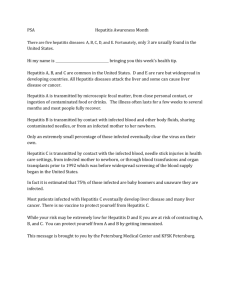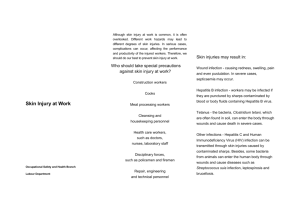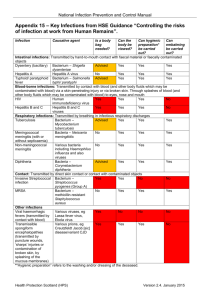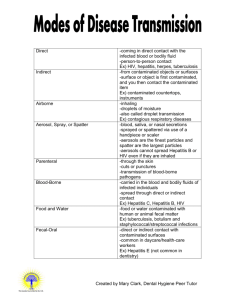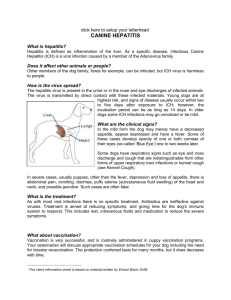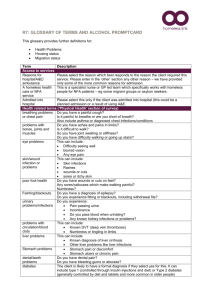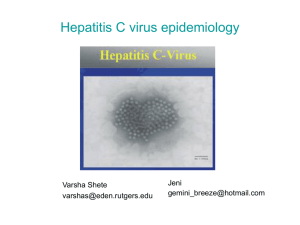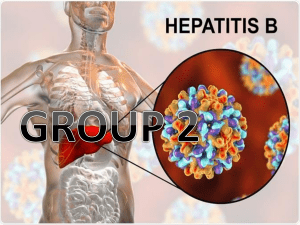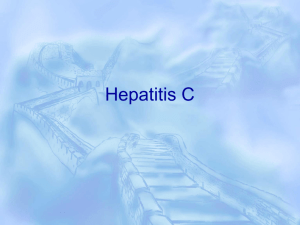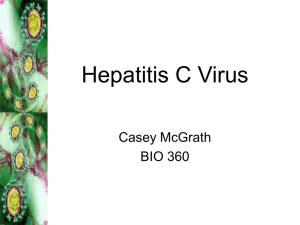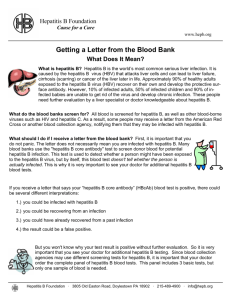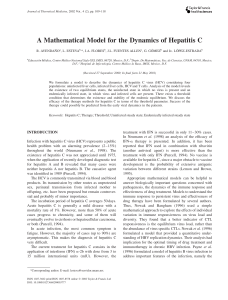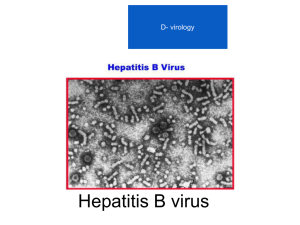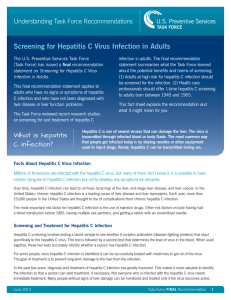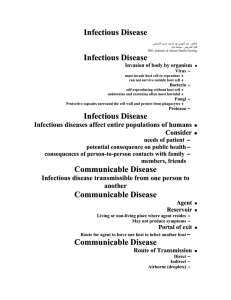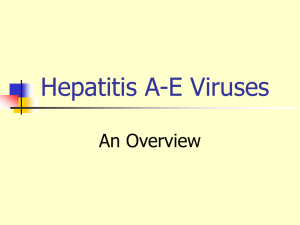Hepatitis A - Christchurch City Council
advertisement
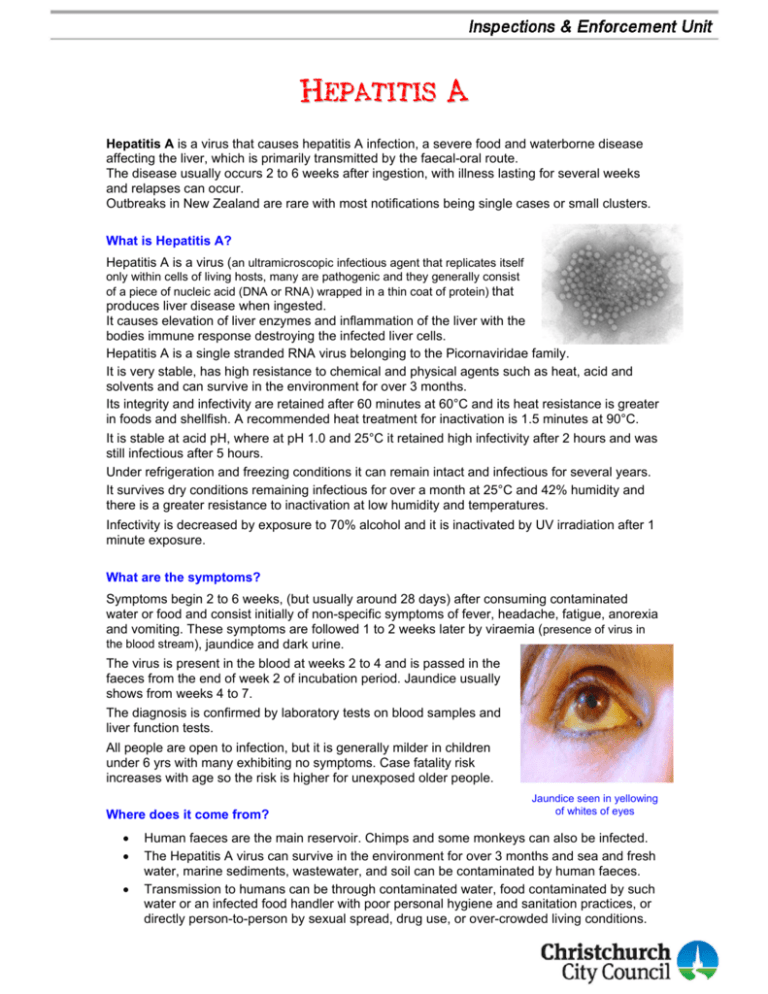
HEPATITIS A Hepatitis A is a virus that causes hepatitis A infection, a severe food and waterborne disease affecting the liver, which is primarily transmitted by the faecal-oral route. The disease usually occurs 2 to 6 weeks after ingestion, with illness lasting for several weeks and relapses can occur. Outbreaks in New Zealand are rare with most notifications being single cases or small clusters. What is Hepatitis A? Hepatitis A is a virus (an ultramicroscopic infectious agent that replicates itself only within cells of living hosts, many are pathogenic and they generally consist of a piece of nucleic acid (DNA or RNA) wrapped in a thin coat of protein) that produces liver disease when ingested. It causes elevation of liver enzymes and inflammation of the liver with the bodies immune response destroying the infected liver cells. Hepatitis A is a single stranded RNA virus belonging to the Picornaviridae family. It is very stable, has high resistance to chemical and physical agents such as heat, acid and solvents and can survive in the environment for over 3 months. Its integrity and infectivity are retained after 60 minutes at 60°C and its heat resistance is greater in foods and shellfish. A recommended heat treatment for inactivation is 1.5 minutes at 90°C. It is stable at acid pH, where at pH 1.0 and 25°C it retained high infectivity after 2 hours and was still infectious after 5 hours. Under refrigeration and freezing conditions it can remain intact and infectious for several years. It survives dry conditions remaining infectious for over a month at 25°C and 42% humidity and there is a greater resistance to inactivation at low humidity and temperatures. Infectivity is decreased by exposure to 70% alcohol and it is inactivated by UV irradiation after 1 minute exposure. What are the symptoms? Symptoms begin 2 to 6 weeks, (but usually around 28 days) after consuming contaminated water or food and consist initially of non-specific symptoms of fever, headache, fatigue, anorexia and vomiting. These symptoms are followed 1 to 2 weeks later by viraemia (presence of virus in the blood stream), jaundice and dark urine. The virus is present in the blood at weeks 2 to 4 and is passed in the faeces from the end of week 2 of incubation period. Jaundice usually shows from weeks 4 to 7. The diagnosis is confirmed by laboratory tests on blood samples and liver function tests. All people are open to infection, but it is generally milder in children under 6 yrs with many exhibiting no symptoms. Case fatality risk increases with age so the risk is higher for unexposed older people. Where does it come from? • • • Jaundice seen in yellowing of whites of eyes Human faeces are the main reservoir. Chimps and some monkeys can also be infected. The Hepatitis A virus can survive in the environment for over 3 months and sea and fresh water, marine sediments, wastewater, and soil can be contaminated by human faeces. Transmission to humans can be through contaminated water, food contaminated by such water or an infected food handler with poor personal hygiene and sanitation practices, or directly person-to-person by sexual spread, drug use, or over-crowded living conditions. How long does it last? Symptoms along with a general incapacity and weakness commonly lasts for several weeks with around 15% of those infected having a prolonged illness or relapsing symptoms over a 6 to 9 month period. Hospitalisation occurs in around 13% of cases. How is it treated? There is no treatment for Hepatitis A apart from rest along with an appropriate low fat diet and avoiding alcohol. Prevention is possible through vaccination for at risk groups including those travelling overseas and food-handlers when the situation is warranted. Can I get this infection again? No, as immunity gained from infection probably lasts for life. Can it spread to others? This disease can be spread to others and strict attention to personal hygiene must be paid. What about work, school, pre-school and child-care? Everyone with this infection should stay off work or school while they have symptoms. Those in High Risk groups, occupations or institutions (infants or children in day-care, school pupils, students, food workers, child-care workers, teachers, and health/care workers) should only return to them after they have been completely free of symptoms for 2 days, and they must stay away again if any symptoms return. Hepatitis A infection is a Notifiable disease in NZ and those employed in High Risk groups may be required to stay away from work until tested free from infection. How can it be prevented or the risk reduced? High incidence of infection is linked to poor hygiene and sanitation standards particularly in developing countries. In developed countries infection is more common in older age groups, and is likely to be either food or waterborne. Foods implicated Overseas include ~ Strawberries, raspberries, salads, shellfish, bread and water. Preventive measures that can be taken to help avoid the illness include ~ • • • • • • Vaccination for those travelling overseas to risk areas. Vaccination of close contacts of cases. Thorough hand washing ~ Before handling or preparing food, or eating, After caring for those infected with the illness, changing nappies, and going to the toilet. Not drinking water from contaminated sources. Not harvesting and consuming shellfish from contaminated waters. Thoroughly washing fruit and vegetables with clean water of drinking standard before use. Health Licensing Section, Inspections & Enforcement Unit, Christchurch City Council




